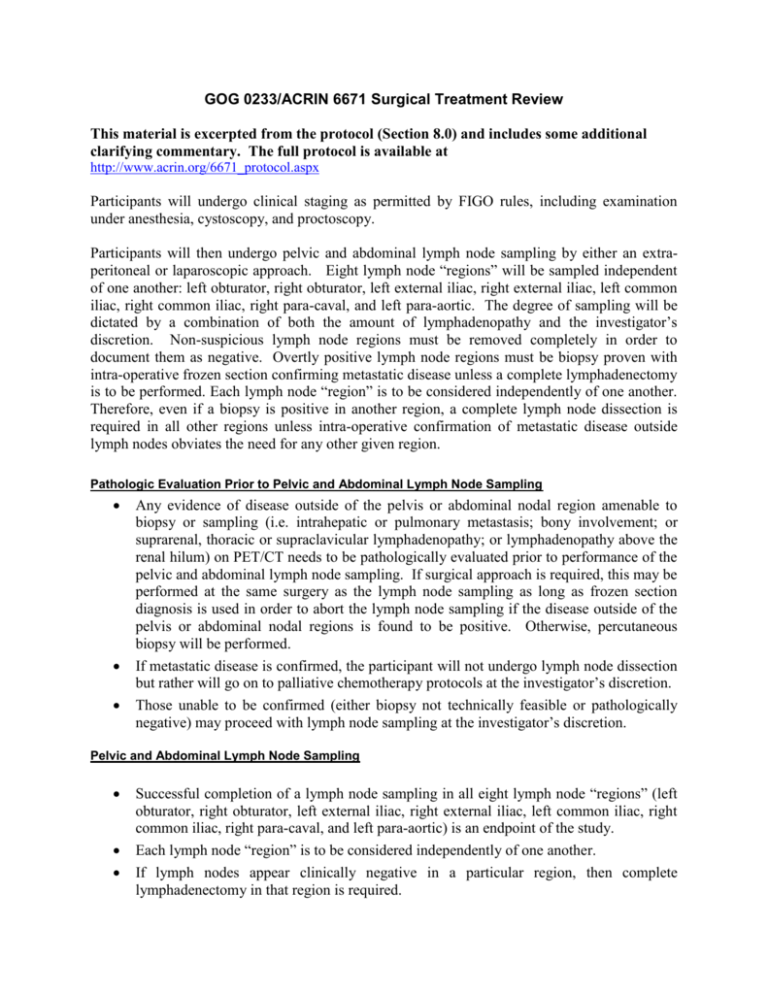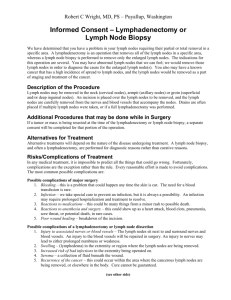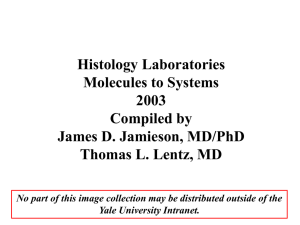Surgical Treatment Document
advertisement

GOG 0233/ACRIN 6671 Surgical Treatment Review This material is excerpted from the protocol (Section 8.0) and includes some additional clarifying commentary. The full protocol is available at http://www.acrin.org/6671_protocol.aspx Participants will undergo clinical staging as permitted by FIGO rules, including examination under anesthesia, cystoscopy, and proctoscopy. Participants will then undergo pelvic and abdominal lymph node sampling by either an extraperitoneal or laparoscopic approach. Eight lymph node “regions” will be sampled independent of one another: left obturator, right obturator, left external iliac, right external iliac, left common iliac, right common iliac, right para-caval, and left para-aortic. The degree of sampling will be dictated by a combination of both the amount of lymphadenopathy and the investigator’s discretion. Non-suspicious lymph node regions must be removed completely in order to document them as negative. Overtly positive lymph node regions must be biopsy proven with intra-operative frozen section confirming metastatic disease unless a complete lymphadenectomy is to be performed. Each lymph node “region” is to be considered independently of one another. Therefore, even if a biopsy is positive in another region, a complete lymph node dissection is required in all other regions unless intra-operative confirmation of metastatic disease outside lymph nodes obviates the need for any other given region. Pathologic Evaluation Prior to Pelvic and Abdominal Lymph Node Sampling Any evidence of disease outside of the pelvis or abdominal nodal region amenable to biopsy or sampling (i.e. intrahepatic or pulmonary metastasis; bony involvement; or suprarenal, thoracic or supraclavicular lymphadenopathy; or lymphadenopathy above the renal hilum) on PET/CT needs to be pathologically evaluated prior to performance of the pelvic and abdominal lymph node sampling. If surgical approach is required, this may be performed at the same surgery as the lymph node sampling as long as frozen section diagnosis is used in order to abort the lymph node sampling if the disease outside of the pelvis or abdominal nodal regions is found to be positive. Otherwise, percutaneous biopsy will be performed. If metastatic disease is confirmed, the participant will not undergo lymph node dissection but rather will go on to palliative chemotherapy protocols at the investigator’s discretion. Those unable to be confirmed (either biopsy not technically feasible or pathologically negative) may proceed with lymph node sampling at the investigator’s discretion. Pelvic and Abdominal Lymph Node Sampling Successful completion of a lymph node sampling in all eight lymph node “regions” (left obturator, right obturator, left external iliac, right external iliac, left common iliac, right common iliac, right para-caval, and left para-aortic) is an endpoint of the study. Each lymph node “region” is to be considered independently of one another. If lymph nodes appear clinically negative in a particular region, then complete lymphadenectomy in that region is required. If lymph nodes appear overtly suspicious, the investigator may choose to perform anything from a complete lymphadenectomy to a biopsy. If anything less than a complete lymphadenectomy is performed, then frozen section confirmation of disease must be performed. If the frozen section is unable to confirm disease, then complete lymphadenectomy is required. Therefore, even if a biopsy is positive in one region, a complete lymph node dissection is required in all other regions not independently proven to be positive by intra-operative confirmation of metastatic disease. Lymph node dissection will be performed in accordance with strict anatomic boundaries. NOTE: This differs from the standard GOG definitions. External Iliac Lymph Nodes: From bifurcation of common iliac artery cranially to the point at which the deep circumflex iliac vein crosses over the external iliac artery caudally. Lateral boundary is the psoas muscle and genito-femoral nerve. Medial boundary is the ureter and superior vesical artery. Deep boundary is the inferior border of the external iliac vein. Obturator Lymph Nodes: Similar to the external iliac lymph node boundaries only extending between the inferior borders of the external iliac vein superiorly and the obturator nerve inferiorly. Common Iliac Lymph Nodes: from bifurcation of the common iliac artery caudally to the bifurcation of the aorta cranially. Lateral boundary is the psoas muscle and medial boundary the common iliac artery. At the surgeon’s discretion, these may be arbitrarily divided in the middle into “high” and “low” common iliac lymph nodes and be sent as separate specimens. Left Para-aortic Lymph Nodes: The caudal boundary is the bifurcation of the aorta. Lateral boundary is the psoas muscle and medial boundary the aorta. The cranial boundary is the point at which the inferior mesenteric artery (IMA) exits the aorta. Positive lymph nodes above the IMA may be resected at the surgeon’s discretion. Abdominal lymph nodes from above the IMA are to be sent as a separate specimen. Right Para-Caval Lymph Nodes: The caudal boundary is the bifurcation of the aorta. Lateral boundary is the psoas muscle and medial boundary the aorta. The deep boundary is the Vena Cava. The cranial boundary is the point at which the inferior mesenteric artery (IMA) exits the aorta. Positive lymph nodes above the IMA may be resected at the surgeon’s discretion. Abdominal lymph nodes from above the IMA are to be sent as a separate specimen. Any lymph node sitting at the boundary between two regions will be considered to belong to the more cranial region by convention (i.e. a palpable lymph node at the bifurcation of the common iliac artery will be considered a common iliac lymph node and one at the bifurcation of the aorta will be considered para-aortic or para-caval). Lymph nodes overlying the aorta will be divided into left para-aortic and right paracaval based upon their relationship to the midline of the aorta. Laparoscopic Lymphadenectomy Pelvic and abdominal lymph node sampling may also be performed through a laparoscopic approach. If the lymph node sampling is performed by a laparoscopic approach and cannot be completed successfully due to technical difficulties (i.e., inadequate exposure), an extra-peritoneal lymphadenectomy must be attempted. If the laparoscopic lymph node sampling was unsuccessful due to unresectable lymph nodes, extra-peritoneal lymphadenectomy is not required, but may be attempted at the surgeon's discretion. At the very least, intra-operative documentation of metastatic disease to the unresectable lymph node region must be documented. Finally, if an overtly suspect lymph node is encountered during a laparoscopic approach, conversion to an extra-peritoneal lymphadenectomy in order to completely remove the lymph node may be performed at the surgeon’s discretion. Extraperitoneal lymph node dissection is not required as long as tissue confirmation of each region has been obtained. In the event of an inability to develop the retroperitoneal spaces (i.e., retroperitoneal fibrosis or adhesions), the procedure should be terminated. If, in the investigator’s opinion, an extra-peritoneal lymph node dissection would be similarly unsuccessful, an extra-peritoneal attempt at lymph node sampling is not necessary. Every reasonable attempt should be made to perform a biopsy of any available lymph nodes. Trans-peritoneal lymph node sampling will not be performed. Surgery will not be performed if there is advanced lymphadenopathy not amenable to surgery It is inappropriate to convert to a trans-peritoneal approach for the sake of removing lymph nodes. GOG-0233/ACRIN 6671: UTILITY OF PREOPERATIVE FDG-PET/CT AND FERUMOXTRAN-10 MRI SCANNING PRIOR TO PRIMARY CHEMORADIATION THERAPY TO DETECT RETROPERITONEAL LYMPH NODE METASTASIS IN PATIENTS WITH LOCOREGIONALLY ADVANCED (IB2, IIA ≥4 CM, IIB-IVA) CARCINOMA OF THE CERVIX SCHEMA (06/09/08) Locoregionally advanced, histologically confirmed invasive cervical cancer (Stages IB2, IIA ≥4 cm, IIB-IVA) Pre-operative ferumoxtran-10 MRI1 (one MRI will be performed 24-36 hours after injection of ferumoxtran-10) and diagnostic PET/CT scan of the abdomen and pelvis and chest (PET/CT scans should be performed on the same machine) (09/09/08) No evidence of disease outside of the pelvis or abdominal nodal region amenable to biopsy or sampling (i.e., intrahepatic or pulmonary metastasis; bony involvement; suprarenal, thoracic, or supraclavicular lymphadenopathy; or lymphadenopathy above the renal hilum on PET/CT) Extra-peritoneal or laparoscopic abdominal & pelvic lymph node sampling Evidence of disease outside of the pelvis or abdominal nodal region amenable to biopsy or sampling (i.e., intrahepatic or pulmonary metastasis; bony involvement; suprarenal, thoracic, or supraclavicular lymphadenopathy; or lymphadenopathy above the renal hilum on PET/CT) Bx (-) Advanced lymphadenopathy not amenable to surgery Biopsy of metastatic disease outside of the pelvis or abdominal nodal region by FNA, core biopsy, or surgical biopsy Bx (+) Chemoradiation therapy protocol to start within 4 weeks of enrollment into the study Chemotherapy protocol for advanced/recurrent disease SPECIFIC AIMS/OBJECTIVES The primary aim of this study is to define the utility of preoperative FDG-PET/CT and ferumoxtran-10 MRI scanning prior to primary chemoradiation therapy to detect retroperitoneal lymph node metastasis in patients with locoregionally advanced carcinoma of the cervix. The optional arm to the study will explore the use of a pre-ferumoxtran-10 MRI with parameters similar to post ferumoxtran-10 MRI to validate that Combidex does not change the size of lymph nodes on Combidex insensitive sequences. METHODS/METHODOLOGY In this study, 325 women will be enrolled. Enrollment will take place in at least 10 sites and is expected to be completed within 36 months from protocol activation. About 30-38 positive cases will have been enrolled by the end of the 20th month of the study. This will be the timing for the performance of the interim analysis. In the optional arm of the study, forty of the 325 patients who consent to undergo 2 MRI (one pre-ferumoxtran-10, and one post-ferumoxtran-10) will provide a cohort of MRI examinations in order to validate the similarity of nodal size in pre and post-ferumoxtran-10 MR images. The analysis for the optional arm is mainly exploratory. ELIGIBILITY (see protocol section 5.0 for details) 1. Patients must have primary, previously untreated, histologically confirmed, locoregionally advanced invasive carcinoma of the cervix or be considered for chemoradiation therapy. 2. Patients that qualify with the above credentials must be able to undergo extra-peritoneal or laparoscopic lymph node sampling. 3. Normal organ function is required within specified parameters (see section 5.1.4 for details). 4. Patients of child-bearing potential must have a negative urine or serum pregnancy test result within 7 days prior to undergoing PET/CT and ferumoxtran-10 MRI. In addition, they would undergo a urine pregnancy test on the day of PET/CT examination. Combidex is injected on the day of PET/CT examination. The urine pregnancy test at the institution should detect hCG at the sensitivity of 25 mIU/mL. If the urine pregnancy test does not have the required sensitivity, a negative serum test is required. Postmenopausal women must have been amenorrheic for at least 12 consecutive months to be considered not to be of child-bearing potential. 5. Patients must sign an approved informed consent form that allows access to prior medical records. 6. Patients must be accrued at an ACRIN affiliated institution that is accredited by GOG. 7. Patients cannot have recurrent invasive carcinoma of the uterine cervix regardless of previous treatment. 8. There can be no known metastases to the lungs, scalene lymph nodes, or metastases to other organs outside of the pelvis or abdominal lymph nodes at the time of the original clinical diagnosis. 9. Patients cannot have had a pelvic or abdominal lymphadenectomy performed. 10. There can be no evidence of prior pelvic radiation therapy for any reason. 11. Any outside circumstances that interfere with the completion of the imaging studies or required follow-up are not permitted. REQUIRED SAMPLE SIZE A total of 325 participants will be enrolled into the study. For the optional arm of the study, 40 of these participants will be enrolled in the study.








